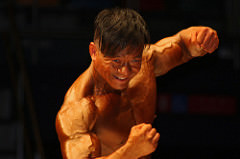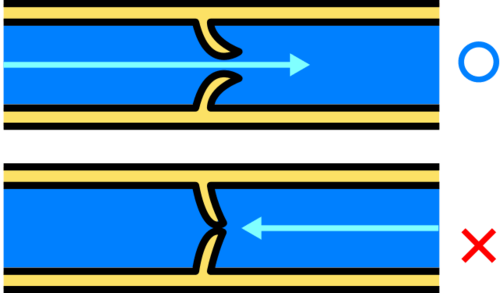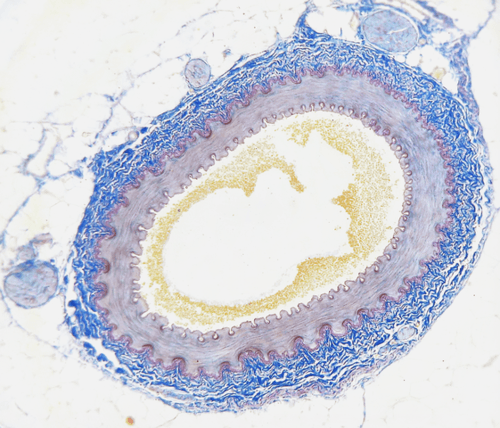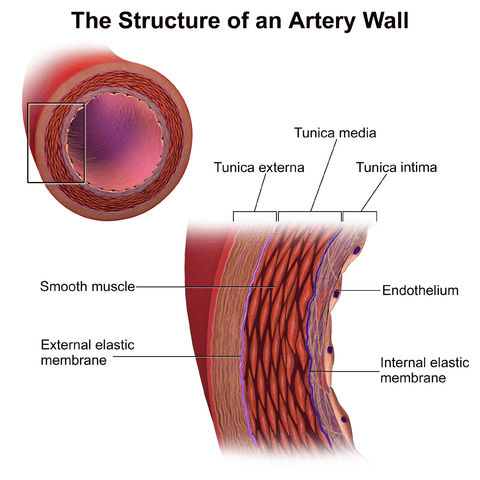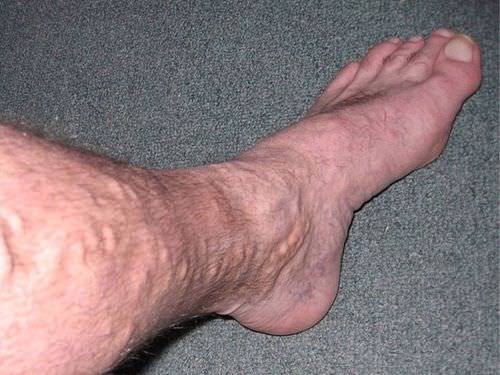鲜血船
Section outline
-
Bulging Veins
::大型蜂鸟Why do bodybuilders have such prominent veins ? Bulging push surface veins closer to the skin. Combine that with a virtual lack of subcutaneous fat, and you have bulging veins, as well as bulging muscles. Veins are one of three major types of blood vessels in the .
::为什么健美健美者有如此突出的血管? 将地表血管推向皮肤附近。 将这种血管与几乎缺乏皮下脂肪结合起来,你还有脉冲血管和肌肉。 肝脏是体内三大类血管之一。Types of Blood Vessels
::血船种类Blood vessels are the part of the cardiovascular system that transports throughout the . There are three major types of blood vessels. Besides veins, they include arteries and capillaries.
::血液血管是心血管系统的一部分,在整个血管中流动。有三种主要类型的血管,除了血管外,还包括动脉和血管。Arteries
::动脉Arteries are defined as blood vessels that carry blood away from the heart. Blood flows through arteries largely because it is under pressure from the pumping action of the heart. It should be noted that coronary arteries, which supply heart muscle with blood, travel toward the heart, but not as part of the blood flow that travels through the chambers of the heart. Most arteries, including coronary arteries, carry oxygenated blood, but there are a few exceptions, most notably the pulmonary artery . This artery carries deoxygenated blood from the heart to the lungs , where it picks up oxygen and releases carbon dioxide. In virtually all other arteries, the hemoglobin in red blood cells is highly saturated with oxygen (95-100 percent). These arteries distribute oxygenated blood to tissues throughout the body.
::血液通过动脉流动,主要因为它受到心脏抽动的压力。应该注意的是,冠状动脉为心脏肌肉提供血液,通向心脏,但不是通过心腔流动血液的一部分。大多数动脉,包括冠状动脉,携带氧化血液,但有一些例外,最明显的是肺动脉。动脉将脱氧血液从心脏送到肺部,取氧气并释放二氧化碳。在几乎所有其它动脉中,红血细胞中的血红蛋白与氧高度饱和(95-100%)。这些动脉将氧化血液传播到整个身体的组织中。The largest artery in the body is the aorta , which is connected to the heart and extends down into the abdomen (see figure ). The aorta has high-pressure, oxygenated blood pumped directly into it from the left ventricle of the heart. The aorta has many branches, and the branches subdivide repeatedly, with the subdivisions growing smaller and smaller in diameter. The smallest arteries are called arterioles.
::体内最大的动脉是动脉,它与心脏相连,并延伸到腹部(见图 ) 。 动脉有高压、氧化血液,直接从心脏左心室抽进。动脉有许多分支,分枝反复分流,直径越来越小,最小动脉被称为动脉。This figure shows the heart and the major arteries of the cardiovascular system. The pulmonary veins are included in the diagram because, like arteries, they carry oxygenated blood.
::此图显示了心血管系统的心脏和主要动脉。 肺血管也包含在图表中, 因为和动脉一样, 它们含有氧化的血液。Veins
::用户Veins are defined as blood vessels that carry blood toward the heart. Blood traveling through veins is not under pressure from the beating heart. It gets help moving along by the squeezing action of , for example, when you walk or breathe. It is also prevented from flowing backward by valves in the larger veins, as illustrated in the figure. Veins are called capacitance blood vessels, because the majority of the body’s total volume of blood (about 60 percent) is contained within veins.
::血管被定义为向心脏输送血液的血管。通过血管流动的血液不会受到心跳的压力。通过挤压的动作可以帮助前进,例如,在行走或呼吸时。如图所示,通过大血管的阀门也阻止它向后流。 血管被称为能力血管,因为大部分身体的血液(大约60%)都包含在血管中。The two flaps that make up a venous valve can open in just one direction, so blood can flow in only one direction through the vein.
::构成一个静脉阀的两片扇形 只能朝一个方向打开 血液只能向一个方向流过静脉Most veins carry deoxygenated blood, but there are a few exceptions, including the four pulmonary veins. These veins carry oxygenated blood from the lungs to the heart, which then pumps the blood to the rest of the body. In virtually all other veins, hemoglobin is relatively unsaturated with oxygen (about 75 percent).
::大部分血管含有脱氧血液,但也有少数例外,包括四种肺血管。这些血管携带氧血液,从肺到心脏,然后将血液泵到身体的其余部分。在几乎所有其它血管中,血红蛋白相对不饱和氧气(约75% ) 。The two largest veins in the body are the superior vena cava — which carries blood from the upper body directly to the right atrium of the heart — and the inferior vena cava , which carries blood from the lower body directly to the right atrium. The inferior vena cava is labeled in the figure . The superior vena cava is not labeled in the figure, but is clearly visible entering the right atrium of the heart. Like arteries, veins form a complex, branching system of larger and smaller vessels. The smallest veins are called venules. They receive blood from capillaries and transport it to larger veins. Each venule receives blood from multiple capillaries.
::身体中最大的两个血管是上方的Vena cava,它直接从上方的血液输送到心脏右端的心部——和下方的Vena cava,它直接从下方的血液输送到右侧的心部。下方的Vena cava标签在图中标注。上方的Vena cava没有标注在图中,但明显进入心脏右侧的心部。像动脉一样,血管形成一个由较大和较小的血管组成的复杂、支流系统。最小的血管被称为毒液,它们从毛细血管中接收血液并将血液输送到更大的血管。每个小血管都从多处获得血液。This diagram shows the heart and major veins of the cardiovascular system. The pulmonary arteries are included in the diagram because, like veins, they carry deoxygenated blood.
::此图显示心血管系统的心脏和主要血管。 肺动脉也包含在图表中, 因为和血管一样, 它们含有脱氧血液。Capillaries
::胶卷Capillaries are the smallest blood vessels in the cardiovascular system. They are so small that only one red blood cell at a time can squeeze through a capillary, and then only if the red blood cell deforms. Capillaries connect arterioles and venules, as shown in the figure . Capillaries generally form a branching network of vessels, called a capillary bed, that provides a large surface area for the exchange of substances between the blood and surrounding tissues.
::Capillary是心血管系统中最小的血管血管。它们太小,一次只有一个红血细胞可以挤穿毛细管,然后只有在红血细胞变形时才能挤穿。如图所示,Capillary连接了动脉和动脉。 Capillary通常形成一个叫作毛细床的分流船网,为血液和周围组织之间的物质交换提供了巨大的表面积。Capillaries form beds of tiny blood vessels that exchange substances with the cells of tissues.
::胶囊形成小血管的床 将物质与组织细胞交换Structure of Blood Vessels
::血液血管结构All blood vessels are basically hollow tubes with an internal space, called a lumen, through which blood flows. The lumen of an artery is shown in cross section in the photomicrograph . The width of blood vessels varies, but they all have a lumen. The walls of blood vessels differ depending on the type of vessel. In general, arteries and veins are more similar to one another than to capillaries in the structure of their walls.
::所有血管基本上都是空洞的管子,内部空间被称作流血的无线管。动脉的润滑剂在照片摄影图的截面中显示。血管的宽度各有不同,但都有一个无线管。血管的壁壁因容器类型不同而不同。一般而言,动脉和血管比墙壁结构的刺青更相似。The lumen is the white space in the center of this cross-sectional slice of an artery. You can see that the walls of the artery have multiple layers.
::是动脉切片中间的白色空间。您可以看到动脉的墙壁有多个层。Walls of Arteries and Veins
::动脉和蔬菜墙壁The walls of both arteries and veins have three layers: the tunica intima, tunica media, and tunica adventitia. You can see the three layers for an artery in the figure .
::动脉和静脉的墙壁分为三层:近距离的Tunica、Tunica媒体和tunica evenitia。您可以看到图中动脉的三层。-
The
tunica intima
is the inner layer of arteries and veins. It is also the thinnest layer, consisting of a single layer of endothelial cells surrounded by a thin layer of
connective tissues
. It reduces friction between the blood and the inside of the blood vessel walls.
::内脏是动脉和血管的内层,也是薄层,由一层内皮细胞组成,由一层薄的连接组织组成,减少血液与血管壁内之间的摩擦。 -
The
tunica media
is the middle layer of arteries and veins. In arteries, this is the thickest layer. It consists mainly of elastic fibers and connective tissues. In arteries, this is the thickest layer, because it also contains
smooth muscle
tissues, which control the diameter of the vessels.
::Tunica 介质是动脉和静脉的中间一层。在动脉中,这是最厚的一层,主要由弹性纤维和连接组织组成。在动脉中,这是最厚的一层,因为它也包含光滑的肌肉组织,可以控制容器的直径。 -
The
tunica externa
(also called tunica adventitia) is the outer layer of arteries and veins. It consists of connective tissue, and also contains
nerves
. In veins, this is the thickest layer. In general, the tunica externa protects and strengthens vessels, and attaches them to surrounding structures.
::外体外体外体外体外体外体外体外体外体外体外体外体外体外体外体外体外体外体外体外体外体外体外体外体外体外体外体外体外体外体外体外体外体外体外体外体外体外体外体外体外体外体外体外体外体外体外体外体外体外体外体外体外体外体外体外体外体外体外体外体外体外体外体外体外体外体外体外体外,外体外体外体外体外体外体外体外体外体外体外体外体外体外体外体外体外体外体外体外体外体外体外体外体外体外体外体外体外体外体外体外体外体外体外体外体外体外体外体外体外体外体外体外体外体外体外体外体外体外体外体外体外体外体外体外体外体外体外的外体外体外体外体外体外体外体外体外体外体外体外体外体外体外体外体外体外体外体外体外体外体外体外体外体外体外体外体外体外体外体外体外体外体外体外体外体外体外体外体外体外体外体外体外体外体外体外体外体外体外体外体外体外体外体外体外体外体外体外体外体外体外体外体外体外体外体外体外体外体外体外体外体外体外体外体外体外体外体外体外体外体外体外体外体外体外体外体外体外体外体外体外体外体外体外体外体外体外体外体外体外体外体外体外体外体外体外体外体外体外体外体外体外体外体外体外体外体外体外体外体外体外体外体外体外体外
A vein has the same three layers as the artery shown here, but the middle layer (tunica media) of a vein is thinner and lacks smooth muscle tissue.
::静脉有与这里显示的动脉相同的三层,但静脉的中间层(图象介质)较薄,缺乏光滑的肌肉组织。Capillary Walls
::毛毛墙墙The walls of capillaries consist of little more than a single layer of epithelial cells. Being just one cell thick, the walls are well-suited for the exchange of substances between the blood inside them and the cells of surrounding tissues. Substances including , oxygen, glucose , and other nutrients , as well as waste products (such as carbon dioxide), can pass quickly and easily through the extremely thin walls of capillaries.
::毛巾的墙壁由一层以上的上皮细胞组成。 墙壁只有一层厚的细胞,很适合在内部血液与周围组织细胞之间交换物质。 包括氧气、葡萄糖和其他营养物在内的物质以及废物产品(如二氧化碳)可以快速而轻松地通过毛巾的极其薄的墙壁。Blood Pressure
::血血压The blood in arteries is normally under pressure because of the beating of the heart. The pressure is highest when the heart contracts and pumps out blood, and lowest when the heart relaxes and refills with blood. (You can feel this variation in pressure in your wrist or neck when you count your pulse.) is a measure of the force that blood exerts on the walls of arteries. It is generally measured in millimeters of mercury (mm Hg), and expressed as a double number — a higher number for systolic pressure when the ventricles contract, and a lower number for diastolic pressure when the ventricles relax. Normal blood pressure is generally defined as less than 120 mm Hg (systolic)/80 mm Hg (diastolic) when measured in the arm at the level of the heart. It decreases as blood flows farther away from the heart and into smaller arteries.
::动脉中的血液通常因心脏跳动而受压力。当心脏收缩并抽出血液时,压力最高;当心脏放松并用血液再充填时,压力最低。 (你可以感觉到手腕或颈部的压力变化,当你数出脉搏时。 )这是血液对动脉壁施加的强度的量度。 通常用毫米汞(毫米汞)测量,以双倍数表示 — — 当心室收缩时,静脉压力的数值较高,当心室放松时,不透气压力的数值较低。 正常血压通常定义为在心脏的手臂中测量不到120毫米汞( 口径) 80毫米汞( 直径)。 当血液从心脏更远处流到小动脉时,血液会减少。As arteries grow smaller, there is increasing resistance to blood flow through them, because of the blood's friction against the arterial walls. This resistance restricts blood flow so that less blood reaches smaller, downstream vessels, thus reducing blood pressure before the blood flows into the tiniest vessels, the capillaries. Without this reduction in blood pressure, capillaries would not be able to withstand the pressure of the blood without bursting. By the time blood flows through the veins, it is under very little pressure. The pressure of blood against the walls of veins is always about the same, and normally no more than 10 mm Hg.
::随着动脉变小,由于血液对动脉墙的摩擦,血液流的阻力越来越大,这种阻力限制了血液流,使血液流到更小的、下游的血管,从而在血液流入最小的血管,即毛细血管之前降低了血压,不减少血压,毛细血管将无法承受血液压力,而不会爆发。当血液流过血管时,血压将很小。血液对血管壁的压力总是一样,通常不超过10毫米汞。Vasoconstriction and Vasodilation
::血管收缩和血管膨胀Smooth muscles in the walls of arteries can contract or relax to cause vasoconstriction (narrowing of the lumen of blood vessels) or vasodilation (widening of the lumen of blood vessels). This allows the arteries — especially the arterioles — to contract or relax as needed to help regulate blood pressure. In this regard, the arterioles act like an adjustable nozzle on a garden hose. When they narrow, the increased friction with the arterial walls causes less blood to flow downstream from the narrowing, resulting in a drop in blood pressure. These actions are controlled by the autonomic nervous system in response to pressure-sensitive sensory receptors in the walls of larger arteries.
::动脉壁的滑动肌肉可以收缩或放松,造成血管收缩(血管润滑)或血管膨胀(血管润滑),从而允许动脉——特别是动脉——视需要进行收缩或放松,以帮助调节血压;在这方面,动脉在花园水管上起到可调适的喷嘴的作用;在缩小时,与动脉壁的摩擦增加,导致血流从缩小到下游,导致血压下降;这些作用由自主神经系统控制,以应对大动脉壁的压力敏感感应器。Arteries can also dilate or constrict to help regulate body temperature, by allowing more or less blood to flow from the warm body core to the body’s surface. In addition, vasoconstriction and vasodilation play roles in the fight-or- flight response, under control of the sympathetic . Vasodilation allows more blood to flow to skeletal muscles, and vasoconstriction reduces blood flow to digestive organs .
::此外,血管收缩和血管膨胀也能够起到战斗或飞行反应的作用,在同情者控制下。 血管膨胀能让更多的血液流向骨骼肌肉,血管收缩会减少血液流向消化器官。Feature: My Human Body
::特质:我的人体The lumpy appearance of this man’s leg is caused by varicose veins. Do you have varicose veins? If you do, you may wonder whether they are a sign of a significant health problem. You may also wonder whether you should have them treated, and if so, what treatments are available. As is usually the case, when it comes to your health, knowledge is power.
::这个人腿部的肿块是由血管变形造成的。你是否有血管变形?如果你有,你也许怀疑它们是否是重大健康问题的征兆。你或许会怀疑它们是否是严重的健康问题的征兆。你是否应该治疗它们,如果应该治疗,有什么治疗。通常情况下,关于你的健康,知识就是力量。V aricose veins are veins that have become enlarged and twisted, because their valves have become ineffective (see figure ). As a result , blood pools in the veins and stretches them out. Varicose veins occur most frequently in the superficial veins of the legs, but they may also occur in other parts of the body. They are most common in older adults, females, and people who have a family history of the condition. Obesity and also increase the risk of developing varicose veins. A job that requires standing for long periods of time, chronic constipation, and long-term alcohol consumption are additional risk factors.
::血管变形是血管变形和变形,因为它们的阀门变得无效(见图 ) 。结果,血管中的血液聚集并拉长了它们。 血管变异最频繁地出现在腿的表面血管中,但也可能在身体的其他地方发生。在老年人、女性和有家庭病史的人中最为常见。肥胖和增加发展变异血管的风险。 需要长期站立、长期便秘和长期酒精消费的工作是额外的风险因素。This diagram shows how varicose veins form.
::此图表显示变血管的形成方式 。Varicose veins usually are not serious. For many people, they are only a cosmetic issue. I n severe cases, however, varicose veins may cause pain and other problems. T he affected leg(s) may feel heavy and achy, especially after long periods of standing. Ankles may become swollen by the end of the day. Minor injuries may bleed more than normal. The skin over the varicosity may become red, dry, and itchy. In very severe cases, skin ulcers may develop.
::对许多人来说,变血管通常并不严重,对许多人来说,它们只是化妆品问题,但在严重的情况下,变血管可能造成疼痛和其他问题,特别是长时间站立之后,受影响的腿可能感到很重和很痒,尤其是长时间后,脚部可能肿胀,小伤可能比正常人多出血。变血管上的皮肤可能变成红色、干燥和痒。在非常严重的情况下,皮肤溃疡可能发作。If you are concerned about varicose veins, call them to the attention of your doctor, who can determine the best course of action for your case. There are many potential treatments for varicose veins. Some of the treatments have potential adverse side effects, and with many of the treatments, varicose veins may return. The best treatment for a given patient depends in part on the severity of the condition.
::如果你担心血管变动,请提请医生注意,医生可以决定你案件的最佳行动方针。对于血管变动,有许多可能的治疗方法。有些治疗方法有潜在的副作用,许多治疗方法也有可能的副作用。对于许多治疗方法,血管变动可能会恢复。给定病人的最佳治疗方法部分取决于病情的严重程度。-
If varicose veins are not serious, then conservative treatment options may be recommended. These include avoiding standing or sitting for long periods, frequently elevating the legs, and wearing graduated compression stockings.
::如果静脉变异不严重,那么可以推荐保守的治疗方案。 其中包括避免长时间站立或坐坐,经常抬高腿,穿累进式压缩袜子。 -
For more serious cases, less conservative, but non-surgical options may be advised. These include sclerotherapy, in which medicine is injected into the veins to make them shrink. Another non-surgical approach is endovenous thermal ablation. In this type of treatment, laser light, radio-frequency
energy
, or steam is used to heat the walls of the veins, causing them to shrink and collapse.
::对于较严重的病例,可以建议采用保守程度较低但非外科治疗方法,其中包括将药物注入血管以使其萎缩的球状疗法。另一种非外科方法是内歇性热衰减。 在这类治疗中,激光光、无线电频率能量或蒸汽被用来加热血管的壁壁,导致血管收缩和崩溃。 -
For the most serious cases, surgery may be the best option. The most invasive surgery is vein stripping, in which all or part of the main trunk of a vein is tied off and removed from the leg while the patient is under general anesthesia. In a less invasive surgery, called ambulatory phlebectomy, short segments of a vein are removed through tiny incisions under local anesthesia.
::对于最严重的病例来说,手术可能是最好的选择。 最具侵入性的手术是切除血管,在切除血管主干干线的全部或部分部分时,当病人处于一般麻醉状态时,切除和切除其腿部。 在较不具有侵入性的手术中,称为动脉切除术的外科手术中,通过局部麻醉下的小切除,切除短片的静脉。
Summary
::摘要-
Blood vessels are the part of the cardiovascular system that carries blood throughout the human body. They are long, hollow
,
tube-like structures. There are three major types of blood vessels: arteries, veins, and capillaries.
::血管血管是心血管系统的一部分,在人体中携带血液,是长长的、空的、像管状的结构,有三种主要类型的血管:动脉、血管和血管。 -
Arteries are blood vessels that carry blood away from the heart. Most arteries carry oxygenated blood. The largest artery is the aorta, which is connected to the heart and extends into the abdomen. Blood moves through arteries due to pressure from the beating of the heart.
::动脉是从心脏流出血液的血管,大多数动脉是氧化血液,最大的动脉是动脉,它与心脏相连,延伸到腹部,血液通过动脉,因为心脏跳动的压力。 -
Veins are blood vessels that carry blood toward the heart. Most veins carry deoxygenated blood. The largest veins are the superior and inferior venae cavae. Blood moves through veins by the squeezing action of surrounding skeletal muscles. Valves in veins prevent backflow of blood.
::血管是血管的血管,向心脏输送血液,大多数血管含有脱氧血液,最大的血管是优等和低等的葡萄树。血液通过骨骼肌肉周围的挤压作用流过血管。血管中的阀门防止血液回流。 -
Capillaries are the smallest
blood vessels
. They connect arterioles and venules. They form capillary beds, where substances are exchanged between the blood and surrounding tissues.
::Capillary是最小的血管,它们连接动脉和输卵管,形成毛细病床,血液和周围组织之间交换物质。 -
The walls of arteries and veins have three layers. The middle layer is thickest in arteries, in which it contains smooth muscle tissue that controls the diameter of the vessels. The outer layer is thickest in veins
,
and consists mainly of connective tissue. The walls of capillaries consist of little more than a single layer of epithelial cells.
::动脉和静脉的墙壁有三层,中间层是动脉中最厚的,其中含有控制容器直径的光滑肌肉组织,外层是血管中最厚的,主要由连接组织组成,外层只有一层以上的上皮细胞。 -
Blood pressure is a measure of the force that blood exerts on the walls of arteries. It is expressed as a double number, with the higher number representing systolic pressure when the ventricles contract, and the lower number representing diastolic pressure when the ventricles relax. Normal blood pressure is generally defined as a pressure of less than 120/80 mm Hg.
::血压是血液对动脉壁所施加的强度的量度。血压是两倍,在心室收缩时,血压是双倍的,数量较高代表静脉压,而数量较低代表心室松动时的非静脉压力。正常血压一般定义为低于120/80毫米汞的压力。 -
Vasoconstriction (narrowing) and vasodilation (widening) of arteries can occur to help regulate blood pressure or body temperature, or to change blood flow as part of the fight-or-flight response.
::动脉的血管收缩(收缩)和血管膨胀(膨胀)可帮助调节血压或体温,或改变血液流,作为战斗或飞行反应的一部分。
Review
::回顾1. What are blood vessels? Name the three major types of blood vessels.
::1.什么是血管?列出三种主要类型的血管。2. Describe arteries. Identify the largest artery in the body.
::2. 描述动脉,辨认身体中最大的动脉。3. Define veins. What are the two largest veins in the body?
::3. 静脉的定义:身体中最大的两种静脉是什么?4. Compare and contrast how blood moves through arteries and veins.
::4. 比较和对比血液如何通过动脉和血管流动。5. What are capillaries, and what is their function?
::5. 毛细管是什么,其功能是什么?6. Compare and contrast the structure of the walls of arteries, veins, and capillaries.
::6. 比较和对比动脉、静脉和刺绣墙壁的结构。7. What is blood pressure, and how is it expressed? What blood pressure is considered normal?
::7. 什么是血压,其表现方式如何?什么血压被认为是正常的?8. Identify functions of vasoconstriction and vasodilation of arteries.
::8. 查明血管收缩和动脉血管膨胀的功能。9. Does the blood in most veins have any oxygen at all? Explain your answer.
::9. 大部分血管中的血液是否都含有氧气?10. True or False: Only one red blood cell can pass through the lumen of a capillary at a given time.
::10. 真实或假:在特定时间,只有一个红色血细胞能够穿过毛细管。11. True or False: The pulmonary artery carries oxygenated blood.
::11. 真实或假:肺动脉含有氧化血液。12. Which tissue in blood vessels is responsible for vasodilation and vasoconstriction? Where is it located?
::12. 血管中的哪些组织对血管血管膨胀和血管收缩负责?13. The blood pressure at the arterioles is generally _________ the blood pressure at the aorta.
::13. 动脉的血压一般为动脉的血压。a. lower than
::a 低于b. higher than
::b 高于c. the same as
::c 与d. not related to
::d. 与14. Explain why it is important that the walls of capillaries are very thin.
::14. 解释为什么必须使刺膜的墙壁非常薄。15. Most of the blood in the body is in the ____________________.
::15. 体内的血液大多在... 。a. capillaries
::a. 毛细膜b. arteries
::b. 动脉c. heart
::c. 心脏心脏d. veins
::d. 静脉Explore More
::探索更多Watch this TED talk to learn more about blood pressure and the significant health risks of high blood pressure:
::观察TED的演讲, 了解更多有关血压及高血压对健康的重大危害:Check out this video to learn about capillaries and nutrient exchange:
::看看这段视频, 了解毛细和营养品交换: -
The
tunica intima
is the inner layer of arteries and veins. It is also the thinnest layer, consisting of a single layer of endothelial cells surrounded by a thin layer of
connective tissues
. It reduces friction between the blood and the inside of the blood vessel walls.
